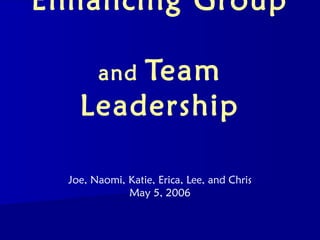
Leadershipppt 090414175137-phpapp01
- 1. Enhancing Group Team and Leadership Joe, Naomi, Katie, Erica, Lee, and Chris May 5, 2006
- 2. Leadership Styles Approach Trait Approach Situational Approach – Paul Hersey and Ken Blanchard FunctionalApproach Transformational Approach
- 3. Three Styles Approach Door number 1 Door number 2 Door number 3
- 4. Who put him in charge? Who makes the decisions? Does anyone get a say? Door Number 1: Authoritarian
- 5. Door Number 2: Democratic Wow! That was a really good idea! What do YOU think? Thank you all for working together!
- 6. Door Number 3: Laissez- faire Bored and unresponsive Whatever attitude Nothing gets accomplished
- 7. Leadership Traits Physical Social Personality
- 8. Physical Make a good first impression Appearance isn’t everything
- 9. Social Charismatic Charming Tactful Popular Cooperative Diplomatic
- 10. Personality Selfconfidence Ambition Taking the initiative Responsibility No guarantees
- 11. Situational Approach Three key factors to determine the most effective leadership style. Most often used to train managers in corporate settings
- 12. Three Key Factors 1. Relationship Behavior 2. Task Behavior 3. Maturity
- 13. Style of Leader Once these factors are considered leaders are able to gauge what style of leadership to use Four styles of leaders Participating Selling Delegating Telling
- 14. Leadership Model
- 15. Functional Approach Task Needs Team Maintenance Individual Needs Needs
- 16. Task Functions Leadership behavior that helps accomplish group’s goal Already assumed by most group members
- 17. Process Functions Leadership behavior that helps maintain a positive group Usually, process functions are not formally assigned
- 18. Transformational Leadership Thetransformational leader influences the group by transforming the group – giving it a new vision – energizing the culture – giving the group a new structure
- 19. Transformational Leadership PeterSenge’s rules in transformational leadership – Build a shared vision – Challenge existing ways of thinking – Be a system thinker
- 20. Transformational Leadership The transformational leader is unique because of the ability to paint a picture of the future for the group members
- 21. Transformational Leadership Establish quality interpersonal relationships with each other - Provide inspiration - Motivation - Intellectual stimulation
